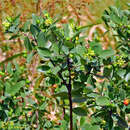Comments
provided by eFloras
See Halda (Genus Daphne, 145-146. 2001) for a more extensive synonymy of this widespread and variable, apomictic species.
- license
- cc-by-nc-sa-3.0
- copyright
- Missouri Botanical Garden, 4344 Shaw Boulevard, St. Louis, MO, 63110 USA
Description
provided by eFloras
Shrubs 0.5-2 m or more tall. Branches reddish brown, glabrous. Leaves opposite; petiole ca. 1 mm; leaf blade reddish brown on both surfaces when dried, obovate, elliptic-oblong, or lanceolate, 2-5 × 0.5-1.5 cm, papery to thinly leathery, both surfaces glabrous, base broadly or narrowly cuneate, apex obtuse or acute; lateral veins dense, slender, at narrow angle to midrib. Inflorescences terminal, capitate, several flowered; peduncle 0.5-1 cm, glabrous. Pedicel 1-2 mm. Calyx yellowish green, 7-12 mm, exterior glabrescent; lobes 4, broadly ovate to oblong, ca. 3 mm, apex acute or obtuse. Stamens 8. Disk scales often 2 or 4. Ovary obovoid or ellipsoid, glabrous or apex sparsely pubescent; style very short; stigma capitate. Drupe red to dark purple, ellipsoid, 7-8 mm. Fl. and fr. summer-autumn.
- license
- cc-by-nc-sa-3.0
- copyright
- Missouri Botanical Garden, 4344 Shaw Boulevard, St. Louis, MO, 63110 USA
Distribution
provided by eFloras
Fujian, Guangdong, Guangxi, Guizhou, Hainan, Hunan, Sichuan, Taiwan, Yunnan, Zhejiang [India, Malaysia, Myanmar, Philippines, Thailand, Vietnam; Australia, Pacific islands east to Fiji; Mauritius, Sri Lanka (introduced)].
- license
- cc-by-nc-sa-3.0
- copyright
- Missouri Botanical Garden, 4344 Shaw Boulevard, St. Louis, MO, 63110 USA
Habitat
provided by eFloras
Forests, rocky shrubby slopes; below 1500 m.
- license
- cc-by-nc-sa-3.0
- copyright
- Missouri Botanical Garden, 4344 Shaw Boulevard, St. Louis, MO, 63110 USA
Synonym
provided by eFloras
Daphne indica Linnaeus, Sp. Pl. 1: 357. 1753; Capura purpurata Linnaeus; D. aquilaria Blanco; D. cannabina Loureiro (1790), not Wallich (1820); D. rotundifolia Linnaeus f.; Eriosolena viridiflora Zollinger & Moritzi; Wikstroemia forsteri Decaisne; W. indica var. viridiflora J. D. Hooker; W. ovalifolia Decaisne; W. ovata Fernández-Villar (1880), not C. A. Meyer (1843); W. valbrayi H. Léveillé; W. viridiflora Meisner.
- license
- cc-by-nc-sa-3.0
- copyright
- Missouri Botanical Garden, 4344 Shaw Boulevard, St. Louis, MO, 63110 USA
Wikstroemia indica: Brief Summary
provided by wikipedia EN
Wikstroemia indica, also known as tie bush, Indian stringbush, bootlace bush, or small-leaf salago (Chinese: 了哥王; pinyin: liǎo gē wáng) is a small shrub with glossy leaves, small greenish-yellow flowers and toxic red fruits. It grows in forests and on rocky, shrubby slopes in central and southeastern China, Vietnam, India, Australia and the Philippines.
- license
- cc-by-sa-3.0
- copyright
- Wikipedia authors and editors

